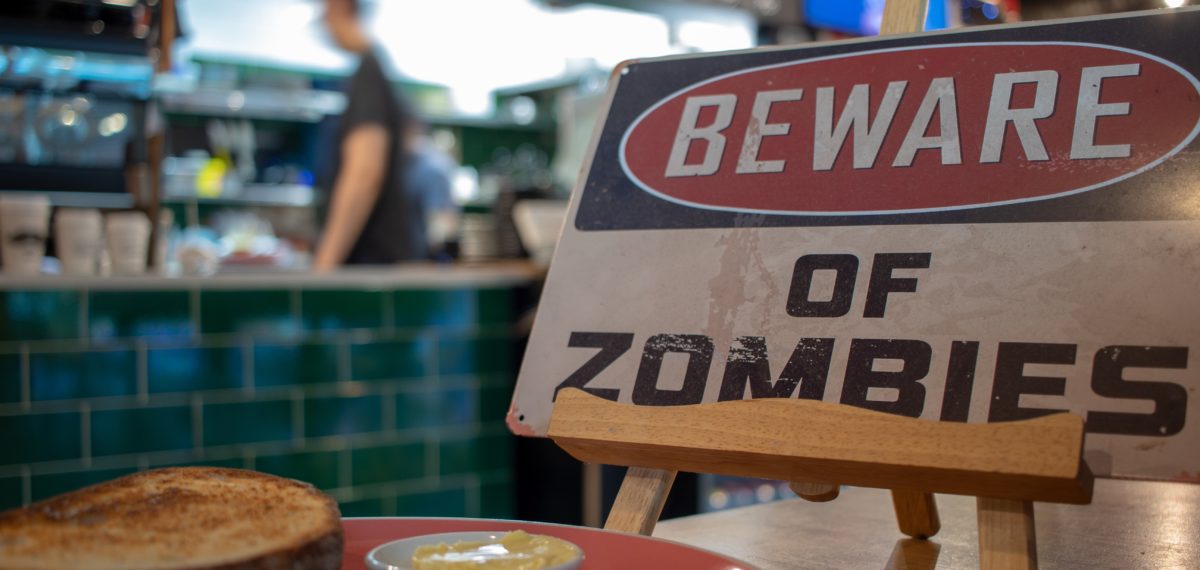
A spooky history of fake blood.
Blood is life. Unless it’s a pint voluntarily given by one of our generous donors in a neat little bag, blood is generally supposed to be in your body.
When it’s not, something is often very wrong: life’s exit. Because of this, the sight of blood often elicits an involuntary, primal reaction.
Blood, when you don’t expect it, is scary.
We generally focus on the life-giving possibilities of blood at Bloodworks through our research, collection, and patient care.
But Halloween is a time for spooky fun, and we need fun more than ever this year—and are likely consuming more media indoors.

For some of us, gory horror is fun, stimulating, and even comforting: a reminder that our blood is where it belongs, even if a fictional character’s is all over the walls.
The representation of blood in entertainment is likely as old as entertainment itself – and we’re not even talking about the Roman gladiators or deadly Mesoamerican ball games.
Legend has it that actors in the time of Shakespeare used real blood and animal entrails on stage, though costumes were expensive and we all know that blood is tricky to get out of fabric.
For years, actors would use a red handkerchief to signify blood during a death scene, but audiences (and theaters) craved more.
The greater the spectacle, the larger the profit.
While blood is a rather free-flowing (no pun intended) byproduct of animal agriculture, the fake stuff is preferred on stage and set for ethical and sanitary reasons, as well as the emotional health of the actors and crew. Real (animal) blood also coagulates quickly, making it unsuitable for the multiple takes of modern storytelling.

The Théâtre du Grand Guignol, nicknamed “the Theatre of Blood and Horror,” was a small venue in Paris known for big scares around the turn of the 20th century. Their mixture of carmine dye and glycerine would sometimes congeal after splattering, like real blood, and inspired the modern genre of horror.
(Note that carmine dye isn’t much less murderous than actual blood: it’s made by boiling cochineal bugs.)
As entertainment shifted from stage to screen, technology and censorship guided American cinematic bloodshed until the mid-1960s.
The Motion Picture Production Code helped save Hollywood’s reputation after a series of scandals in the 1920s but required that most violence happened off screen. Too much carnage was improper, and believed to inspire actual murder.

In black and white, blood is more about the consistency and drip factor than the color. Bosco brand chocolate syrup stood in for blood in Alfred Hitchcock’s Psycho and George A Romero’s Night of the Living Dead.
They’re coming for you, Barbra… and they taste delicious.
The invention of the plastic squeeze bottle advanced special effects as much as ice cream sundaes, allowing the chocolate sauce to squirt and spatter in creepy new ways.
British film didn’t have the same restrictions on blood as the US. “Kensington Gore” is both a London street name and the recipe for theatrical blood invented in the 1960s by a retired British pharmacist for Hammer Studios, a production company in the Kensington neighborhood.

Kensington Gore was largely food coloring and golden syrup. It was very sticky and very red.
Which worked well on screen: by the late 1960s, color film dominated the industry.
Some of movie history’s most famous blood is based on Kensington Gore. In 1968, the Motion Picture Association of America had more or less stopped enforcing their code, and replaced it with the modern ratings system, opening up a whole new vein of gruesome opportunity.

While director Brian de Palma may have had an added level of comfort with blood as the son of a surgeon, the pig’s blood in the notorious scene in Carrie was actually the combination of karo syrup and food coloring (and left actress Sissy Spacek smelling like a candy apple.)
Director Stanley Kubrick was so nervous about pulling off the elevator of blood effect in The Shining with hundreds of gallons of fake blood that he couldn’t even be in the room when it was filmed.

Effects master Dick Smith further revolutionized the medium by adding zinc oxide and Kodak Photo-Flo to Kensington Gore to create the realistic – and poisonous – blood in classics like The Exorcist, Taxi Driver, and The Godfather.
The blood in Taxi Driver was so graphic that it needed to be desaturated in post-production to avoid an X rating, which director Martin Scorsese actually thought looked creepier.

Like nearly everything in modern movies, fake blood is being phased out in favor of even faker blood: CGI. Digital blood helps keep actors’ make-up fresh, and is one less thing to worry about on set. And it would have saved Kubrick a lot of stress.
However, theatrical blood isn’t limited to the stage.
Moulage is the art of applying realistic mock injuries to dummies or live actors to mimic real-world emergency situations. It’s used in training simulations for first responders, military personnel, nurses, and other healthcare professionals.
Practitioners of moulage say this added visual realism allows students to diagnose and treat injuries faster, and imitates the urgency of a real crisis and all of the emotions that come with it.

In actual patient treatment, however, there is no substitute for human blood.
Bloodworks needs at least 1,000 generous donors each day to roll up their sleeves to help people in need in our communities: children fighting cancer, transplant recipients, mothers bleeding after childbirth, trauma patients, burn victims, and everyone else who depends on donated blood to survive.
Because, in reality, monsters are fake (yes, even vampires), but there’s nothing scarier than blood that’s not on the shelf when it’s needed.
Schedule your next appointment today via our donor portal or by calling 1-800-398-7888.
And need more Halloween treats? Satisfy your indulgent and altruistic sides with our just-for-fun candy guide to blood donations.
Tell Us What You Think!